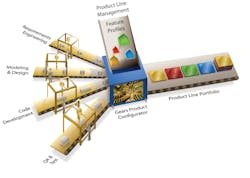As the automotive and aerospace industries design more sophisticated mechanical systems embedded with electronics and software, the ability to create, deliver and maintain these products becomes more costly and complex. In addition, many manufacturers work in product-centric development, meaning each individual product line evolves independent of the portfolio. Not only does that take little advantage of design commonalities, but it also makes it difficult to trace information—such as a defect—back across the product family.
Enter BigLever Software, Inc., a provider of product line engineering (PLE) systems, which recently announced a partnership with product lifecycle management (PLM) vendor Aras Corp. The two are teaming up to help companies manage the cradle-to-grave lifecycle of diversified product lines by unifying mechanical, software, and electrical engineering within a common framework.
The Aras Innovator/BigLever Gears Bridge, available now, integrates the companies’ PLE and PLM functionality. While BigLever’s PLE framework is agnostic, it takes a lot of integration to plug in a PLM system. The duo has eased that integration burden for the end user by using BigLever’s PLE Bridge API to enable a seamless connection with Aras Innovator software.
Now, all product assets—which may sit in disparate systems—will sit on top of the BigLever Gears framework and access a “common language” to automate product lifecycle management across the enterprise.
“It is common way to assembly assets and integrate tools across a product family,” says Cathy Martin, BigLever’s vice president of marketing.
For example, rather than using a bill-of-materials to determine product components, companies can use a “bill of features” to identify mechanical, electrical, wiring, software, calibrations, requirements, designs, test cases, and documentation.
In addition, by providing a holistic view of feature variations and shared assets, the companies say that manufacturers have a “single source of truth” for all software, electronic and mechanical functions.
“Companies engaged in systems engineering will have a single, end-to-end [system] that can handle the complexity of today’s product requirements and take full advantage of emerging technologies and capabilities,” says Aras President Peter Schroer.
According to BigLever, this is the first PLM partnership for the company, but the agreement is not exclusive. In addition, BigLever is working with application lifecycle management companies.
Of course, integrating these assets also means product-centric teams will also have to transition to a product line structure and share information, which represents a culture shift. But industries like automotive and aerospace, which are no longer able to manage complex products using the traditional disconnected approach, are seeing the value in a PLE offering, BigLever officials say.

